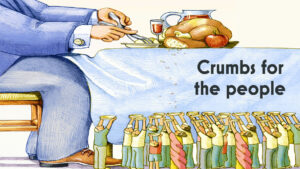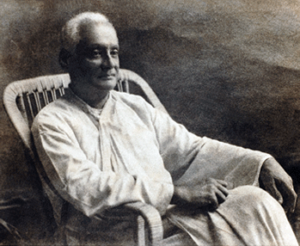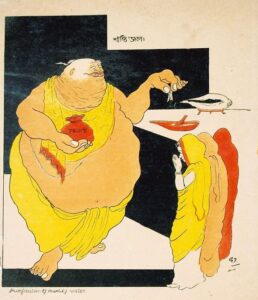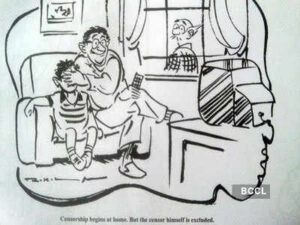
Satire is an inexorable force in the field of creative expression, a lethal concoction of wit and humour to challenge the very foundations of power. One cannot help but be impressed by satire’s strength, and its unrivalled capacity to speak truth to power in a way that entertains, enlightens, and empowers.
Throughout its history, India, a nation rich in history and culture, has witnessed the overwhelming prowess of sarcasm. Satire has been a constant companion from the days of Indian independence right to the present, bravely exposing authority and casting light on critical societal concerns. However, the entire core of this creative form is under siege today, suffocated by censorship and bigotry.
During the War of Independence, humour developed as an intriguing tool for mobilizing the populace. Visionary minds utilized the pen deftly, employing sarcasm to quench the longing for liberty and destroy colonial control. Writers, poets, and cartoonists mocked the British Raj with abandon, ripping down their egos and exposing their foibles. Humour became a connecting thread, linking together a varied populace and cultivating a collective awareness that desired independence.

Gaganendranath Tagore’s satirical work demonstrates his remarkable capacity to use aesthetic expression as a vehicle for social observation and critique. “Purification By Cow Dung,” a 1917 work, encapsulates his skill of satirical art by ingeniously combining religious procedures with underlying absurdities. Tagore depicts a Hindu priest carefully putting cow excrement on flowers and plants, a symbolic gesture of cleansing, all while adding a cow in the backdrop with a human-like face of scepticism. This juxtaposition is a remark on the frequently mindless commitment to rituals and practices, showing the irony and contradictions inherent in blind devotion. In another piece, “Purification By Muddy Water,” Tagore presents a priest sprinkling muddy holy water on devotees while holding a sack of money, aptly named “Tonka Debi.”  This not only critiques the manipulation and greed within the religious hierarchy but also speaks to the vulnerability of believers. Tagore’s satirical works, steeped in wit and symbolism, transcend time, resonating as much in the 21st century as they did in the early 20th century, making him an artist whose insight into societal complexities remains as relevant as ever.
This not only critiques the manipulation and greed within the religious hierarchy but also speaks to the vulnerability of believers. Tagore’s satirical works, steeped in wit and symbolism, transcend time, resonating as much in the 21st century as they did in the early 20th century, making him an artist whose insight into societal complexities remains as relevant as ever.
Satire continued its path after independence, developing to reflect the nation’s changing difficulties. It dared to criticize the newly constituted administration, calling it to account for the people’s hopes and dreams. The satirical depictions of governmental personalities and societal idiosyncrasies served as a mirror to reflect the nation’s accomplishments and failures.
Satire evolved throughout time, taking on the function of a watchdog, a defender of democracy and social justice. It went beyond political satire, tackling deep-seated themes like casteism, corruption, gender injustice, and religious dogmas. Satirists, with their pens as swords, fought as gallant soldiers against injustice, causing society to reflect and evolve.
Back in the 1970s/80s, the Common Man shared and presented the frustration of every common man in India by focusing on issues rampant during the time such as the withering of democracy during emergency, high inflation and unemployment. From the 1950s, R.K. Laxman’s “Common Man” became an enduring symbol representing the everyday difficulties, aspirations, and hopes of ordinary citizens. With his sharp wit and incisive pen, Laxman crafted a character that deeply resonated across societal strata.  The Common Man, dressed in a checked coat and dhoti, adopted the position of a quiet spectator in the nation’s upheaval, deploying humour to comment on the socio-political landscape. Though they started as being lighthearted, Laxman’s cartoons have developed into timeless masterpieces that people can relate to at various stages of their lives. These cartoons, sometimes hidden under humour, gently criticize the country’s sociopolitical systems and its caretakers, while occasionally showing moral inconsistencies and double standards. These comments, on the other hand, are more sarcastic nudges than severe criticisms, frequently leading to good-natured banter or moments of introspection.
The Common Man, dressed in a checked coat and dhoti, adopted the position of a quiet spectator in the nation’s upheaval, deploying humour to comment on the socio-political landscape. Though they started as being lighthearted, Laxman’s cartoons have developed into timeless masterpieces that people can relate to at various stages of their lives. These cartoons, sometimes hidden under humour, gently criticize the country’s sociopolitical systems and its caretakers, while occasionally showing moral inconsistencies and double standards. These comments, on the other hand, are more sarcastic nudges than severe criticisms, frequently leading to good-natured banter or moments of introspection.
One recurring theme depicted in Laxman’s cartoons is “Election Fever.” The role of the common man during elections is vividly depicted, frequently standing patiently in long lines, symbolizing the people’s enduring dedication to the democratic process despite the obstacles they face.
Laxman’s keen observations also extended to the realm of economic challenges. He expertly touched on the effects of inflation on the regular citizen’s daily life in his cartoons. The Common Man is typically represented as battling with rising costs, successfully focusing awareness on the economic challenges confronting the middle class.
Furthermore, Laxman’s creative remark was not limited to the political domain. He successfully captured the Common Man’s reactions to corruption, communal conflicts, and other societal quandaries as he explored numerous social topics. These depictions reflect the public’s common worries, demonstrating Laxman’s keen grasp of the nation’s pulse.
Asim Trivedi emerged as a notable satirist in the twenty-first century, utilizing his cartoons to provide incisive criticism on widespread topics of corruption and socioeconomic concerns. Trivedi used his creative humour to challenge politicians, bureaucrats, and corporate elites, bringing attention to their alleged wrongdoings and ethical failings. His drawings were a strong instrument for resistance, exposing the Indian society’s underbelly of power and privilege. However, Trivedi’s daring labour came at a cost. In 2012, he became embroiled in a protracted judicial struggle after being charged with sedition for his outspoken humour. This incident sparked extensive debate regarding creative freedom and the limits of satirical speech in the current Indian setting. Trivedi’s journey shows satire’s powerful influence in holding authority responsible, while also highlighting the difficulties that artists might confront when they dare to criticize the current status quo.
Nonetheless, despite its unquestionable importance in sparking change, satire is increasingly experiencing resistance. Artists who formerly enjoyed a valued position in contemporary India are now susceptible to intimidation and persecution. Those in positions of power, unable to withstand the criticism of satire, have resorted to stifling free expression in the guise of nationality and cultural preservation.
Consider the countless cases in which comedians, authors, and cartoonists have faced legal action, threats, or even physical assault for daring to mock those in power or question the existing quo. The once-thriving satirical scene is now cloaked in self-censorship, as artists fear repercussions for expressing their creativity and critical viewpoints. When satire, a critical component of dissent and discussion, is suppressed, the vitality of India’s democracy is jeopardized.
The war against satire is an attack on the fundamentals of democracy, not merely on creative freedom. Satire is a gauge of a free society in which individuals may freely question, confront, and discuss. We discourage discourse, reduce accountability, and compromise by silencing satire.
Finally, the power of satire has been a vital element of India’s history, working as a driving force for change during the independence movement and thereafter. Its capacity to question authority and draw attention to social concerns has been both revolutionary and liberating. The present atmosphere of intolerance and repression, however, threatens to stifle this powerful form of artistic expression. As a country, we must recognize that defending satire is vital to defending democracy itself, fostering a culture that lives on open debate, dissent, and advancement. Let us rejoice in the force of satire, love its ability to speak truth to power, and guarantee that it remains free, reverberating through the annals of Indian history.

